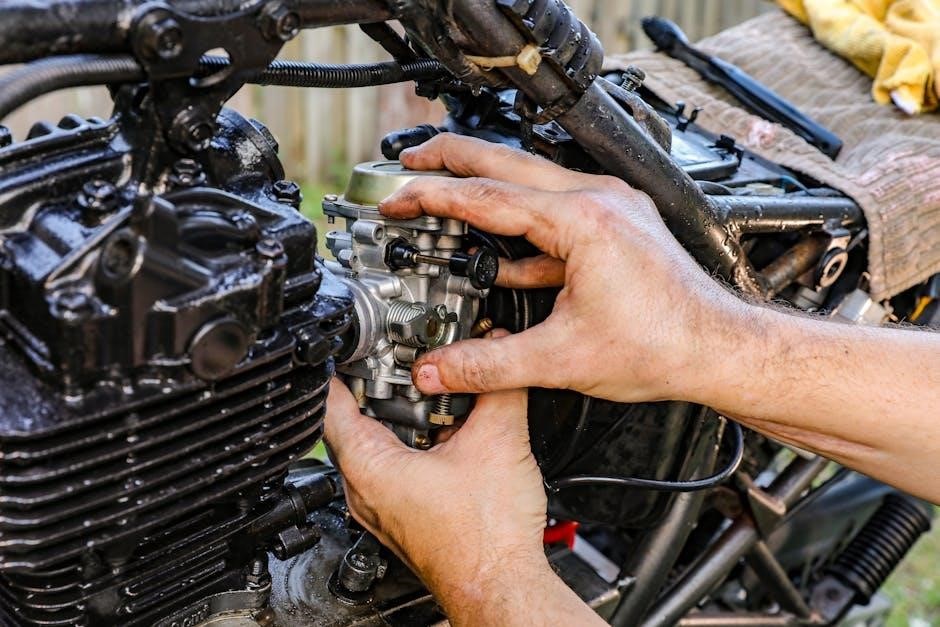Zenith Carburetor Manual PDF: A Comprehensive Guide
This guide will help you navigate the world of Zenith carburetors․ It focuses on finding and utilizing Zenith carburetor manuals in PDF format․ These manuals provide crucial information for repair, maintenance, and tuning․ Accessing these resources ensures optimal performance and longevity for your carburetor․ They also help when troubleshooting common issues․
Zenith carburetors have a storied history in the automotive and industrial worlds, renowned for their reliability and performance across various applications․ These carburetors were commonly found in a wide range of vehicles, from classic cars to tractors, and even in some aircraft engines, making them a versatile choice for many manufacturers․ Understanding their design and function is crucial for anyone working on vintage engines or seeking to maintain the original specifications of their equipment․
The Zenith carburetor operates on the principle of creating a precise fuel-air mixture to ensure efficient combustion․ They were designed with various features, including adjustable jets and sophisticated float systems, allowing for fine-tuning to suit different engine requirements․ This adaptability is one of the reasons why they remained popular for so many years․ Recognizing the specific model and series of your Zenith carburetor is the first step in finding the correct manual and parts․
Whether you are a seasoned mechanic or a hobbyist, a solid understanding of Zenith carburetors is essential․ A detailed manual will provide you with the necessary information to properly service and maintain these classic fuel delivery systems․ By diving into the specifics of your particular model, you can unlock the full potential of your engine and ensure its continued smooth operation․
Availability of Zenith Carburetor Manuals
Finding Zenith carburetor manuals often involves searching various online resources, as these documents are essential for proper maintenance and restoration․ Many vintage engine enthusiasts and mechanics have digitized these manuals, making them available as PDF downloads․ Websites dedicated to classic car and tractor restoration are excellent starting points․ These sites frequently host collections of manuals covering a wide range of Zenith models․

Online forums and communities related to specific vehicles or engines that used Zenith carburetors are also valuable resources․ Members often share manuals they have acquired over the years․ It’s a good idea to use specific search terms, including the Zenith model number and the phrase “PDF manual,” to narrow your search and improve your chances of finding the exact document you need․ Always verify the manual’s source to ensure its accuracy and completeness․
Specialized carburetor parts suppliers sometimes offer manuals or links to manuals on their websites․ These suppliers understand the importance of having the right information for rebuilding and tuning carburetors․ Checking with these vendors can provide access to valuable resources․ Remember that some manuals might be available for free, while others may require a small purchase․ The investment is worthwhile when considering the time and potential damage saved by having the correct guidance․
Identifying Your Zenith Carburetor Model
Before diving into a Zenith carburetor manual, accurately identifying your specific model is essential․ Zenith produced a wide variety of carburetors for different engines and applications, each with unique specifications and adjustments․ The model number is typically stamped or engraved on the carburetor body itself․ Look for markings on the main body, float bowl, or mounting flange․
Sometimes, the tag is attached to the carburetor with a screw or rivet․ If the tag is missing or illegible, you may need to consult vehicle or engine documentation․ The original manufacturer’s service manuals often list the correct carburetor model for specific applications․ Online parts catalogs and forums can also be helpful in cross-referencing engine types with corresponding Zenith carburetor models․
Pay close attention to any prefixes or suffixes in the model number, as these can indicate specific variations or modifications․ Taking clear photos of your carburetor from multiple angles can aid in identification․ Comparing these photos with images in online resources or manuals may help narrow down the possibilities․ If you’re still unsure, consider seeking assistance from experienced mechanics or carburetor specialists who can visually identify your Zenith carburetor model․ Accurate identification is crucial for using the correct manual and ordering the right parts․
Zenith Carburetor Exploded Views and Parts Identification
Zenith carburetor manuals frequently contain exploded views, which are invaluable for understanding the carburetor’s construction and identifying individual parts․ These diagrams illustrate how the various components fit together, providing a clear visual reference during disassembly and reassembly․ Each part in the exploded view is typically labeled with a number or code corresponding to a parts list․
The parts list provides the name, description, and often the original Zenith part number for each component․ This information is crucial when ordering replacement parts or rebuild kits․ Common parts identified in exploded views include jets, needles, floats, gaskets, valves, and screws․ The diagrams also show the location of passages and channels within the carburetor body, which is helpful for understanding fuel and air flow․
When using an exploded view, pay close attention to the orientation of parts and the order in which they are assembled․ Some components may have specific directional requirements, and incorrect assembly can lead to malfunctions․ High-quality manuals often include multiple exploded views showing different sections of the carburetor in detail․ These detailed views can be particularly helpful when working on complex carburetors with numerous small parts․ By carefully studying the exploded views and parts lists, you can confidently identify and replace any worn or damaged components in your Zenith carburetor․
Disassembly Instructions for Zenith Carburetors
Disassembling a Zenith carburetor requires a systematic approach to avoid damaging delicate parts․ A Zenith carburetor manual provides step-by-step instructions, often accompanied by illustrations or diagrams, to guide you through the process․ Before starting, ensure you have a clean workspace and appropriate tools, including screwdrivers, wrenches, and pliers․ It’s also advisable to wear gloves to protect your hands from fuel and solvents․
The manual will typically begin with instructions on removing the carburetor from the engine․ Once removed, the first step usually involves draining any remaining fuel from the carburetor bowl․ Next, the manual will detail the order in which to remove the various components, such as the float bowl, jets, needles, and valves․ It’s crucial to follow this order carefully, as some parts may be interconnected or require specific tools for removal․
As you disassemble the carburetor, keep track of the location of each part and label them if necessary․ This will make reassembly much easier․ Pay close attention to any shims, washers, or seals, as these are often small and easily lost․ The manual will also provide instructions on how to remove any stuck or corroded parts without damaging them․ By following the disassembly instructions in the Zenith carburetor manual, you can safely and effectively take apart your carburetor for cleaning, inspection, and repair․

Cleaning and Inspection Procedures
After disassembling your Zenith carburetor, thorough cleaning and inspection are crucial for optimal performance․ The Zenith carburetor manual outlines the proper procedures for cleaning each component, typically recommending the use of carburetor cleaner or solvent․ Ensure adequate ventilation and wear eye protection when working with these chemicals․ Small parts can be soaked in cleaner, while larger components can be sprayed and scrubbed with a soft brush․
Pay close attention to cleaning the jets and passages, as these are prone to clogging․ Use fine wires or carburetor cleaning tools to remove any obstructions․ Rinse all parts thoroughly with clean solvent and allow them to air dry completely․ Avoid using compressed air, as it can force debris further into the passages․
Once the parts are clean, carefully inspect them for wear, damage, or corrosion․ Check the float for leaks or dents and ensure the needle valve is in good condition․ Inspect the jets for proper sizing and replace any that are worn or damaged; Examine the gaskets and seals for cracks or deterioration and replace them as needed․ The Zenith carburetor manual provides detailed specifications for each part, allowing you to identify any components that need replacement․ By following these cleaning and inspection procedures, you can ensure your Zenith carburetor is in top condition for reassembly and reliable performance․
Zenith Carburetor Adjustment and Tuning
Proper adjustment and tuning are essential for maximizing the performance and efficiency of your Zenith carburetor․ The Zenith carburetor manual provides specific instructions for adjusting various parameters, including idle speed, mixture, and main jet settings․ Before making any adjustments, ensure the engine is at its normal operating temperature and that the ignition system is properly timed․

Begin by adjusting the idle speed screw to achieve the desired RPM, as specified in the manual․ Next, fine-tune the idle mixture screw to obtain the smoothest possible idle․ The manual will guide you on whether to turn the screw clockwise (leaner) or counterclockwise (richer) to achieve optimal combustion․ For main jet adjustments, consult the manual for the correct jet size based on your engine specifications and operating conditions․
Road testing the vehicle after making adjustments is crucial to evaluate performance under various loads and speeds․ Pay attention to any signs of hesitation, stumbling, or excessive fuel consumption․ The Zenith carburetor manual offers troubleshooting tips for addressing common tuning issues․ Remember to make small, incremental adjustments and re-evaluate performance after each change․ By following the recommended procedures in the manual, you can optimize your Zenith carburetor for smooth operation and fuel efficiency․
Main Jet Adjustment
The main jet plays a critical role in regulating fuel flow at higher engine speeds and loads․ Adjusting the main jet on a Zenith carburetor involves selecting the appropriate jet size to match your engine’s specific requirements․ The Zenith carburetor manual provides valuable information on determining the correct main jet size based on factors such as engine displacement, compression ratio, and intended use․
To adjust the main jet, you’ll typically need to remove the carburetor’s float bowl․ Then you can access the main jet․ Refer to the manual for specific instructions on disassembly and reassembly․ It’s crucial to use the correct tools and techniques to avoid damaging the carburetor components․
When selecting a new main jet, start with a size slightly larger than the original․ This will ensure a rich mixture initially․ Then gradually decrease the jet size until the engine runs smoothly and efficiently at higher speeds․ Road testing is essential to evaluate the effects of each jet change․ Listen for any signs of detonation or lean running, such as hesitation or surging․ The Zenith carburetor manual provides guidance on interpreting these symptoms and selecting the appropriate jet size for optimal performance and fuel economy․ Always consult the manual for specific jetting recommendations and safety precautions․
Idle Mixture Adjustment
The idle mixture adjustment is crucial for smooth engine operation at idle speed․ Zenith carburetors typically feature an idle mixture screw that controls the air-fuel ratio at idle․ This adjustment affects the engine’s responsiveness and overall performance at low speeds․ A properly adjusted idle mixture ensures a stable and consistent idle, preventing stalling and rough running․
To adjust the idle mixture, locate the idle mixture screw on your Zenith carburetor․ Refer to the Zenith carburetor manual for the exact location and orientation of the screw․ Start by warming up the engine to its normal operating temperature․ Then, with the engine idling, gradually turn the idle mixture screw in or out, listening carefully to the engine’s response․
Turning the screw inward typically leans the mixture, while turning it outward enriches the mixture․ Aim for the smoothest possible idle with the highest vacuum reading․ The Zenith carburetor manual provides detailed instructions on using a vacuum gauge to optimize the idle mixture․ Be sure to make small adjustments and allow the engine to stabilize before making further changes․ Over-adjusting the idle mixture can lead to poor performance and fuel economy․ Always consult the manual for specific adjustment procedures and troubleshooting tips․
Zenith Carburetor Rebuild Kits and Parts
Maintaining a Zenith carburetor often requires replacing worn or damaged parts․ Rebuild kits offer a convenient solution, providing essential components for restoring a carburetor to its original condition․ These kits typically include gaskets, seals, O-rings, and sometimes even jets and needles․ Sourcing high-quality rebuild kits is crucial for ensuring a reliable and long-lasting repair․
When selecting a rebuild kit, verify that it is specifically designed for your Zenith carburetor model․ The Zenith carburetor manual will list the correct kit number and any specific requirements․ Using the wrong kit can lead to compatibility issues and potential damage to the carburetor․ If a complete rebuild isn’t necessary, individual parts like floats, jets, and solenoids can also be purchased separately․
Several online retailers and specialty shops offer Zenith carburetor parts․ The Carburetor Doctor and other reputable suppliers carry a wide selection of components․ Ensure that the parts you purchase are genuine Zenith or high-quality replacements․ Using inferior parts can compromise the carburetor’s performance and longevity․ Always consult the Zenith carburetor manual for part numbers and specifications before making any purchases․ With the right rebuild kit and quality parts, you can restore your Zenith carburetor to its optimal working condition, ensuring smooth engine performance․
Troubleshooting Common Zenith Carburetor Problems

Zenith carburetors, while reliable, can experience issues affecting engine performance․ Common problems include hard starting, rough idling, stalling, poor acceleration, and fuel leaks․ The Zenith carburetor manual is invaluable for diagnosing these issues, providing exploded views and troubleshooting charts․
Hard starting can result from a faulty choke, clogged jets, or an improperly adjusted idle mixture․ Rough idling often indicates vacuum leaks, dirty jets, or incorrect idle speed settings․ Stalling can be caused by a lean fuel mixture, a malfunctioning fuel pump, or a blocked fuel filter․ Poor acceleration might stem from a restricted main jet or a worn accelerator pump․
Fuel leaks are typically due to deteriorated gaskets or seals․ When troubleshooting, begin by visually inspecting the carburetor for any obvious signs of damage or leaks․ Check fuel lines and connections for tightness․ Use the Zenith carburetor manual to identify the specific components related to the problem․ For instance, if the engine runs lean, consult the manual for main jet adjustment procedures․ If you suspect a clogged jet, carefully disassemble and clean it․ Remember to refer to the manual for proper disassembly and reassembly instructions․ With systematic troubleshooting and the aid of the Zenith carburetor manual, you can effectively diagnose and resolve many common Zenith carburetor problems, restoring optimal engine performance․
Where to Purchase Zenith Carburetor Manuals PDF
Online Resources for Zenith Carburetor Information
The internet offers a wealth of information for Zenith carburetor enthusiasts․ Numerous websites, forums, and online communities are dedicated to providing support, technical data, and historical insights․ These resources can be invaluable for identifying parts, troubleshooting issues, and locating Zenith carburetor manuals in PDF format․
Many specialized carburetor parts suppliers maintain online databases with Zenith carburetor specifications․ These databases often include exploded views, parts lists, and application charts․ Online forums and discussion groups provide a platform for sharing experiences, asking questions, and receiving advice from fellow enthusiasts and experts․ Some websites host downloadable Zenith carburetor manuals in PDF format, either for free or for a small fee․ It’s important to verify the accuracy and reliability of information found online, as not all sources are created equal․
Consider consulting multiple sources and cross-referencing information before making any adjustments or repairs․ Look for reputable websites with established track records and positive user reviews․ When downloading PDF manuals, be cautious of potential malware or viruses․ Ensure that the website is secure and trustworthy before downloading any files․ By carefully navigating the online landscape, you can tap into a vast reservoir of knowledge and resources to support your Zenith carburetor endeavors․ These online resources are a supplement to a physical manual․



